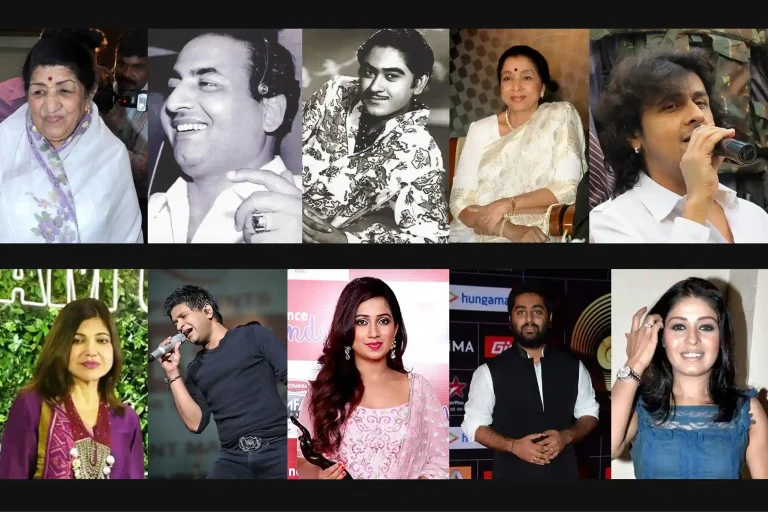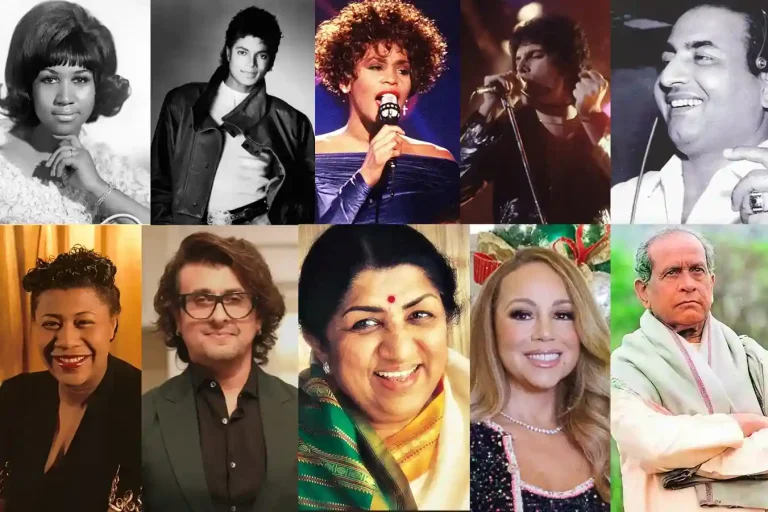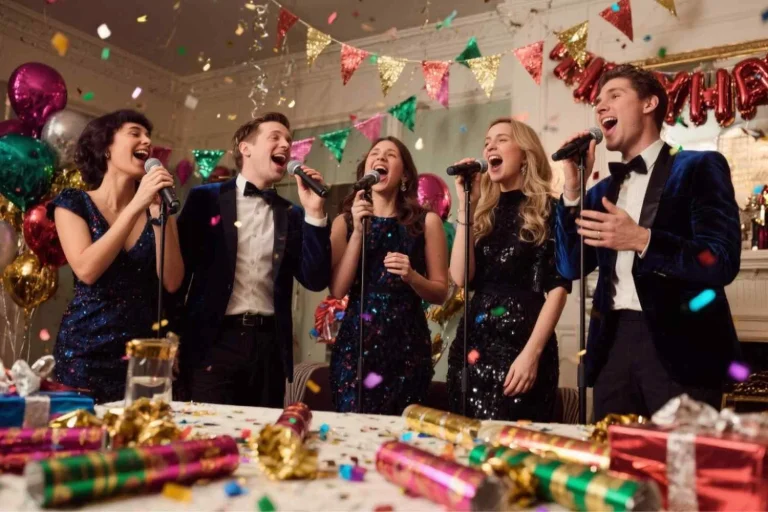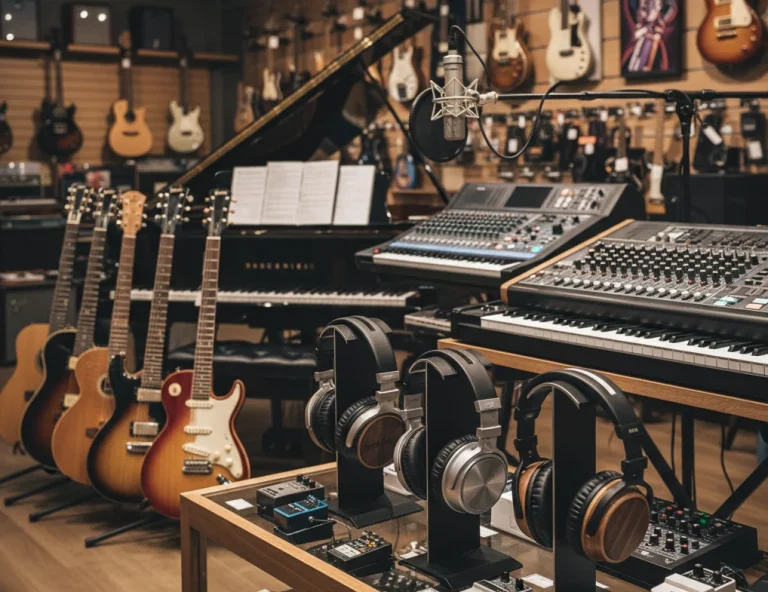All Topics
- Alchemizing Music Concepts for Students
- Artist Spotlight
- artium gift card
- Artium Maestros
- Artium News
- buying guide
- Carnatic Music
- Devotional Music
- Editorials by Ananth Vaidyanathan
- Film Music
- Guitar
- Hindustani Classical Music
- Indian Classical Music
- Indian Folk Music
- Insights
- Instruments
- Karaoke Singing
- Keyboard
- Kids Music
- maestros
- Music Education
- Music for Kids
- Music Industry
- Music Instruments
- Music Legends
- Music Theory
- Music Therapy
- Piano
- piano guide
- Success Stories
- Tamil Film Music
- Telugu Film Music
- Time Theory
- Tools
- Uncategorized
- Vocal Singing
- Vocals
- western classical music
- western music
- Western vocal music
The Evolution of Bollywood Music: From Classics to Contemporary Hits
The Evolution of Bollywood Music: From Classics to Contemporary Hits

Table of Contents
Coming out in 1931, India’s first sound motion film, Alam Ara by Ardeshir Irani, featured seven songs. It was during this time that music in cinema started emerging as a theme.
Over time, films like Shihreen Farihad by JF Madaan, featuring 42 songs, and Indra Sabha having 71 songs, set the stage for Bollywood music to come to the fore. Bollywood music has seen several transformative stages, from the classic to contemporary, owing to changes in cinematography, music techniques, influence from the West, changing society, and experimentation.
In this blog, we will explore the different stages of the evolution of Bollywood music, starting from the 1930s to the present times. So, let us take a look.
History and Evolution of Bollywood Music
Motion pictures in India emerged in the early 18th century. But it was not until 1931 that the first Hindi film song was released. In the beginning, Bollywood films would feature an exhaustive list of songs. But, with time, the number of songs was reduced and made to enhance the storyline and be context-appropriate.
As time passed, exceptional lyricists, music directors, and singers created a new genre of Bollywood music by amalgamating Indian musical culture & tradition and Western elements. It ushered in a new age of Bollywood music. Gradually, the Bollywood music industry has become a booming business. With ever-changing societal conditions and assimilating influences from lands apart, music has evolved and adapted over time.
Let us embark on the journey to understand the evolution of Bollywood music.
The Golden Era (1930s-1950s)
The Golden Era of Bollywood music is often regarded as a golden period in Indian cinema and music history. The melodies and lyrics from this era have left an indelible mark on the cultural landscape of India, and their influence can still be felt in contemporary Bollywood music.
This era is celebrated for its rich musical heritage, which continues to be cherished and celebrated by music enthusiasts worldwide.
- Fusion of traditional and modern elements: The music of this era blended Indian classical music, regional folk tunes, and traditional melodies with modern orchestration and arrangements. Composers like Naushad, Anil Biswas, and C. Ramachandra were masters at infusing a sense of nostalgia and cultural richness into their compositions.
- Integration of classical ragas: Composers in the golden era efficiently incorporated classical ragas into film songs. Their mastery of classical music allowed them to create compositions that were not only entertaining but resonated with connoisseurs of classical music.
- Iconic Composers and Playback Singers: The Golden Era witnessed the rise of legendary music composers like Naushad, S.D. Burman, Shankar-Jaikishan, and O.P. Nayyar. These composers created timeless melodies that are cherished by generations. Playback singers like Lata Mangeshkar, Mohammad Rafi, Kishore Kumar, and Geeta Dutt emerged during this era and become iconic voices of Bollywood music.
- Patriotic and Social Themes: The music of the Golden Era often revolved around patriotic and social themes, reflecting the spirit of the independence struggle and societal issues of the time. Songs like “Ae Mere Watan Ke Logon” by Lata Mangeshkar and “Door Hato Ae Duniya Walo” by Mohammad Rafi became anthems of patriotism.
The Era of Romance and Melody (1960s-1970s)
The era of romance and melody in Bollywood music is celebrated for its timeless compositions, emotional depth, and the musical brilliance of the composers and playback singers. The songs from this period continue to evoke nostalgia and hold a special place in the hearts of Bollywood music enthusiasts, making it one of the most beloved and cherished eras in the history of the Indian Film Industry.
- Timeless soundtracks: Many films of this era boasted remarkable soundtracks that contributed significantly to the success of the movies. Classics like “Mera Saaya”, “Aradhana,” “Bobby,” “Kati Patang,” and “Amar Prem” are examples of films with unforgettable music.
- Musical duets: The era saw the rise of memorable duets, where male and female playback singers collaborated on melodious and romantic songs. These duets showcased the chemistry between the on-screen couples and became immensely popular.
- Influence on popular culture: Many of the songs of this era continue to be remade, reimagined, and referenced in modern Bollywood films, demonstrating their enduring appeal.
- The versatility of composers: Composers of this era showed their versatility by experimenting with various musical styles. While they excelled in composing romantic ballads, they also delivered foot-tapping numbers and peppy songs, making them true musical maestros.
- Composers like RD Burman, Laxmikant-Pyarelal, and Kalyanji-Anandji experimented with diverse musical styles, incorporating elements of rock, disco, and funk into their compositions.
Discover the Art of Singing Old Hindi Film Songs through Our Exclusive Hindi Film Song Course!
The Disco and Dance Influence (1980s-1990s)
The disco and dance influence era in Bollywood music was a vibrant and dynamic period that brought a fresh and modern essence to the industry. It showed the adaptability of Bollywood music to evolving trends and demonstrated its ability to connect with a diverse and ever-changing audience.
- Introduction of disco music: The disco craze of the late 1970s and early 1980s had a significant influence on Bollywood music during this era. Composers like Bappi Lahiri and Biddu introduced disco beats and rhythms into film songs, giving them a more groovy and upbeat feel.
Learn To Sing 90’s hit Bollywood Songswith Our Exclusive Hindi FIlm Music Course
- Peppy and energetic compositions: Songs of this era were characterised by their peppy and high-energy compositions. The use of synthesisers, drum machines, and electronic instruments added a modern touch to the music, making it more dance-friendly.
- Dance-driven films: Several Bollywood films during this era were centred around dance and featured elaborate dance sequences. Music played a pivotal role in making these dance-driven films successful.
- Relevance in Contemporary Bollywood: Many songs from this era continue to be popular and relevant in contemporary Bollywood. They are often remixed or recreated, reflecting their enduring appeal among audiences.
The Modern Era of Hindi Film Music (2000-2010s)
The Modern era in Bollywood music is characterised by versatility, experimentation, and adaptability to contemporary trends. The fusion of various music styles, innovative compositions, and technological advancements have made Bollywood music a global phenomenon. It has an appeal for audiences with diverse backgrounds. As Bollywood continues to evolve, its music remains a powerful expression of Indian culture and creativity on the world stage.
Learn To Sing Modern Remix Hindi Film Music With Our Exclusive Hindi Film Music Course
- Technological advancements: The modern era witnessed significant advancements in digital technology, which revolutionised the production and distribution of music. Digital recording, editing, and distribution platforms became more accessible to musicians and composers.
- New Generation of playback singers: The era introduced a new generation of playback singers, such as Sonu Nigam, Arijit Singh, Shreya Ghoshal, Sunidhi Chauhan, and Neha Kakkar. Their versatile voices and emotive tones gained immense popularity.
- Item Songs and Remixes: The modern era saw a rise in the popularity of item songs and remixes. These high-energy and often sensuous songs became a staple in Bollywood films and were often used for promotional purposes.
- Remakes and revivals: The modern era saw a trend of remakes and revivals of classic Bollywood songs. Some iconic songs from the past were reimagined and introduced to a new generation of listeners.
- Diversity in song themes: Bollywood music during this period embraced a wide range of themes, from romantic ballads and dance numbers to socially relevant and motivational songs. The diversity of themes reflected the changing tastes and preferences of the audience.
The Era of Remakes (2010s-Present)
The era of remakes saw a resurgence of remake Bollywood songs. Bollywood music continued to evolve, adapting to changing technology and global influences.
- Criticism and controversy: Remakes became commercially successful and enjoyed widespread popularity. But, they also faced criticism for allegedly diluting the original charm of classic songs.
- Experimentation with Sounds: Composers and music composers in this era experimented with diverse sounds, infusing Bollywood music with elements of electronic dance music, hip-hop, and other Bollywood music genres.
- Collaborations and Cross-Cultural Fusion: Bollywood music increasingly engaged in cross-cultural collaborations, with artists from different countries and genres contributing to the industry. These collaborations expanded the global reach and appeal of Bollywood music.
- Music Streaming Platforms: The popularity of music streaming platforms like Saavn, Gaana, and Spotify reshaped the way people consume music. These platforms offered vast libraries of songs, including Bollywood classics, accessible to users worldwide.
- Soundtracks for Web Series and Short Films: The rise of digital streaming platforms led to the creation of web series and short films. They require original soundtracks. Bollywood musicians and independent artists contributed to the music for these digital productions.
Wrapping up
The evolution of Bollywood music can be traced through these stages. From “Mere Dil Ke Chain” by Kishore Kumar to “Jashn-E-Bahaaraa” by A.R. Rahman, Bollywood music has amassed a huge fan following. Through constant experimentation and style adaptation, it will continue to evolve further, offering us soulful music!
Want to sing like the experts? Begin your musical journey with a FREE 1:1 music learning session today!
FAQs on Bollywood Film Music Journey
Bollywood music originated in 1931 with India’s first sound motion picture Alam Ara, which featured seven songs. This marked the beginning of music as a central element of Hindi cinema. Early films often had numerous songs, sometimes over 40 per movie, blending Indian classical traditions, folk melodies, and gradually Western influences. Over time, this evolved into a more refined integration of songs into storytelling.
Indian music, especially in Bollywood, has evolved dramatically across decades. From the Golden Era (1930s–1950s) dominated by classical ragas and soulful melodies, to the romantic and melodic tunes of the 1960s–1970s, the disco and dance beats of the 1980s–1990s, and the fusion-heavy, tech-driven compositions of the 2000s–present, Bollywood music has constantly adapted to cultural shifts, technological advancements, and global influences while retaining its essence.
Bollywood has shifted from being melody-focused in its early years to experimenting with modern genres, global collaborations, and digital production techniques. Earlier, songs often carried patriotic, romantic, or social themes. Today, the industry balances soulful ballads, remakes of old classics, high-energy dance tracks, and cross-cultural fusions. The way music is consumed has also changed, with streaming platforms becoming the primary medium for audiences worldwide.
Bollywood music is over 90 years old, dating back to 1931 with Alam Ara. Over the decades, it has transitioned through distinct phases—Golden Era melodies, romantic duets, disco, modern fusion, remixes, and streaming-era hits—reflecting India’s cultural, social, and cinematic evolution.







